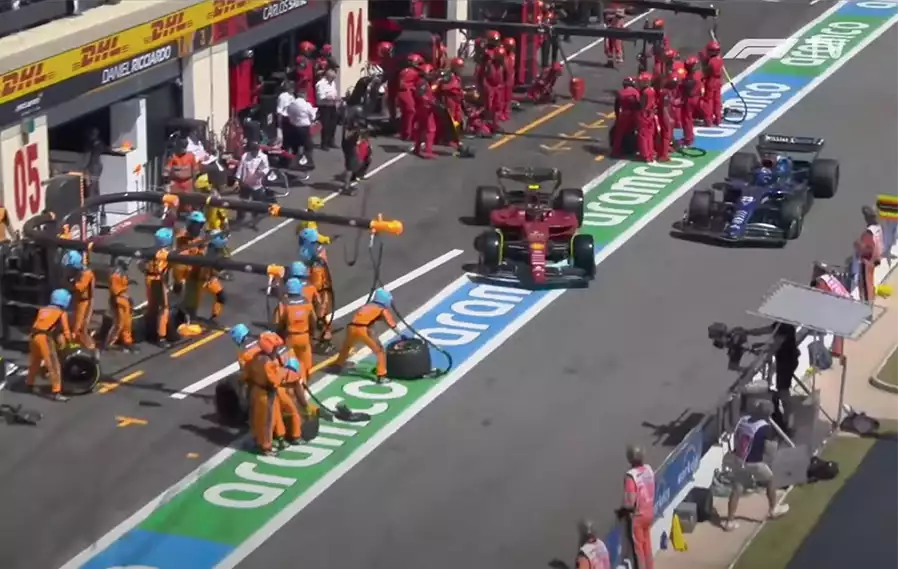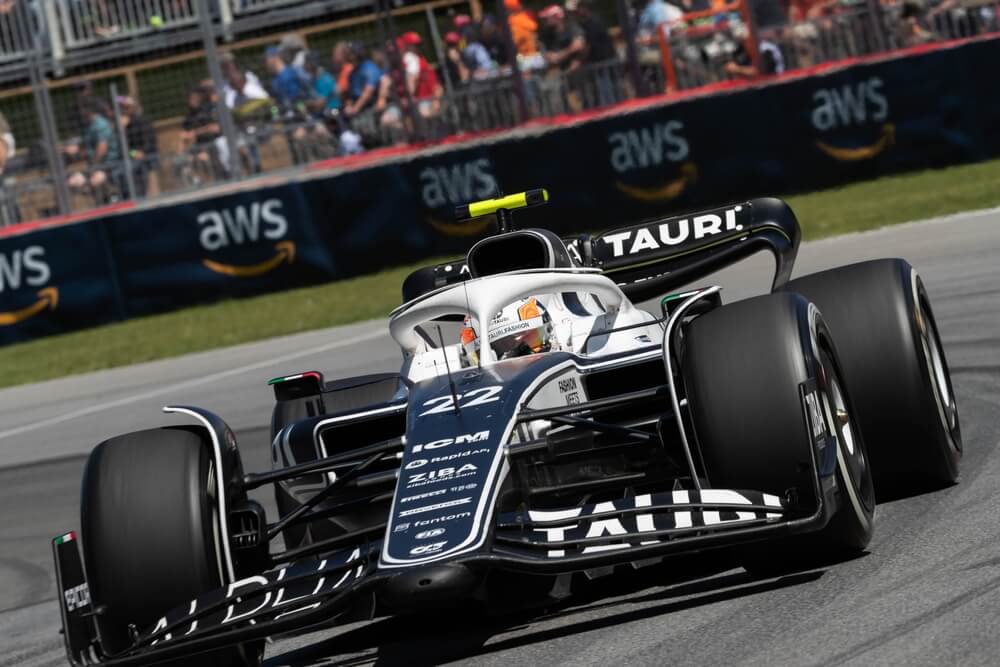Formula 1 racing is a thrilling spectacle, with drivers navigating high-speed turns and weaving through intense air currents. But while the drivers may seem to be in complete control at all times, there’s an underlying force behind every corner they take: turbulence.
But what exactly is turbulence? In this article, we’ll explore the science behind it and how it affects both car and driver performance. So buckle up for a ride through the turbulent world of Formula 1
What does turbulence in Formula 1 mean?
Turbulence is a phenomenon in Formula 1 racing that refers to the chaotic, unpredictable flow of air around a race car. It is caused by high speeds and can cause disruptions in the air pressure around the car, creating pockets of high-pressure and low-pressure zones.
These turbulent conditions can have a significant impact on the performance of both the car and the driver as it affects the aerodynamics of the car, making it less stable and more difficult to control.
Teams and engineers must work diligently to optimize the car’s aerodynamics in order to minimize the effects of turbulence and maximize performance on the track.
Key takeaways
Here are some key aspects that you should know about regarding turbulence in F1:
- Turbulence is an unpredictable force caused by high speeds in F1 racing that can disrupt the air pressure around the car.
- It affects the aerodynamics of the car, making it more difficult to control and less stable.
- Teams work hard to optimize the car’s aerodynamics in order to minimize the effects of turbulence.
- The three main causes of turbulence are aerodynamic forces, weather conditions, and tire pressure.
- Drivers must be prepared for turbulent conditions and use their skill to navigate through them.
- By understanding turbulence, teams can better prepare for its effects and maximize performance.
Causes of Turbulence
Now that we understand what turbulence is and how it affects Formula 1 racing let’s explore the causes of this phenomenon.
Aerodynamic Forces
The first cause of turbulence in Formula One (F1) racing is aerodynamic forces. The cars used in F1 are designed to generate a lot of downforces to help them stay fast through corners.
Unfortunately, this downforce also creates a wake of turbulent air behind the car. This turbulent air is characterized by high-velocity fluctuations and changes in pressure, which can disrupt the stability and handling of the car. This makes it more difficult for the driver to control the car, especially when taking high-speed turns.
Tyre Pressure
Another factor that can lead to turbulence in F1 racing is tire pressure. When the tires are set at their proper inflation level. The tyre produce a contact patch with the track that provides grip and traction for the car.
However, if the tire pressure is too low, the contact patch will be bigger than it should be. That would lead to more friction between the tire and the track. This increased friction causes the tire to heat up faster and deform. Furthermore that creates turbulence around the tire and disturbing the aerodynamics of the car.
On the other hand, if the tire pressure is too high, then the contact patch will be smaller than it should be and reduce grip and traction for the car. This can cause instability when driving at high speeds, bouncing on uneven surfaces which creates turbulence around the tire. That can affect the airflow around the car, making it more difficult to control.
Weather Conditions
Weather conditions, such as wind, rain, and temperature, can all lead to turbulence in Formula One (F1) racing. Strong winds can cause turbulence due to their high velocity fluctuations, altering the aerodynamic performance of the car and potentially leading to control issues.
Moreover, during wet conditions, the track surface may become slick and reduce the grip of the car’s tires on the track, which can cause skidding and spins. This can lead to instability and turbulence around the car.
Similarly, colder temperatures can prevent the tires from warming up sufficiently, while hot temperatures can cause them to overheat. Both of these conditions can reduce the amount of grip and traction available on the track, leading to more skidding and turbulence around the car.
Effects of Turbulence
Now that we’ve discussed the causes of turbulence, it’s important to understand how this phenomenon affects F1 racing.
Loss of Traction
One of the most dangerous effects of turbulence for an F1 car is the loss of traction on the track. This can occur because high-speed airflows over and around the car are disrupted, reducing downforce, which is what pushes the car onto the track and gives it added stability and grip.
Without this steady downforce, drivers may struggle to maintain control of their vehicles and be at risk of losing speed or even causing catastrophic accidents. To stay safe, drivers must be able to anticipate and adjust to any turbulence that may arise during a race.
If they fail to do so, the loss of traction caused by turbulent airflows can make controlling the car difficult and very dangerous.
Loss of Vehicle Control
When there’s no traction, a driver can easily lose control of their vehicle. The lack of grip caused by turbulence prevents the car from responding to small adjustments and movements, leading to oversteer or understeer that can cause spinouts or other dangerous situations.
The loss of control is especially dangerous when driving at high speeds because it gives drivers less time to react and correct the car’s path. During Formula One races, any loss of control can have serious consequences for both the driver and other competitors on the track.
Reduced Performance
Finally, turbulence can affect the performance of an F1 car. High-speed turns and tight corners become difficult to navigate when there’s not enough grip on the track due to turbulent airflows. This reduces the speed at which drivers can complete a lap and makes it harder to maintain a competitive edge against other racers.
In addition, it can also cause instability in the car’s aerodynamics, reducing its top speed and overall performance. To stay competitive, drivers must be able to adjust their driving style to account for any turbulence on the track.

Techniques to Reduce Turbulence
Now that we’ve discussed the effects of turbulence let’s look at some techniques that can be used to reduce its impact.
Adjusting the Car Setup
Adjusting the car setup is one of the best ways to reduce turbulence in F1 racing. Teams can adjust various components, like the front and rear wings, diffuser, and floor to optimize the airflow around the car. This helps to reduce air disturbance and maintain control of the vehicle at high speeds.
Additionally, adjustments can also be made to the suspension, brakes, and tires to improve handling stability. By making these changes, drivers can minimize turbulence and ensure their vehicles remain predictable even in challenging conditions.
Optimizing Tyre Pressure
As we describe above how tire pressure is one of the leading causes of turbulence. So optimizing tire pressure is also important to reduce and manage turbulence. Teams need to ensure that the tires are inflated correctly for each race, as this will improve grip and traction on the track.
In addition, teams need to ensure that all four tires are inflated equally. If one tire is more inflated than the others, this can cause instability in the car and lead to turbulence. By properly inflating the tires before a race, teams can minimize turbulence and maximize their performance on the track.
Modifying Aero Package
By making modifications to the aerodynamic package of a Formula 1 car, engineers can reduce turbulence and maintain stability. To reduce it, engineers can adjust the shape or angle of elements such as wings, diffusers, and bargeboards.
Furthermore, engineers can also design aerodynamic components with a focus on reducing drag. By lowering drag, teams can improve the car’s top speed as well as its ability to navigate corners without experiencing excessive levels of turbulence.
Frequently asked questions about Turbulence
Turbulence in Formula One is a disturbance in the air caused by uneven air pressure. This can make it difficult for drivers to maintain control of their car at high speeds, as there’s less grip on the track and more instability in the aerodynamic package.
The three main causes of turbulence in Formula One are aerodynamic forces, weather conditions, and tire pressure.
The three main ways to reduce turbulence in Formula One are by adjusting the car setup, optimizing tire pressure, and modifying the aerodynamic package. When done correctly, these techniques can help drivers maintain control of their vehicles and ensure they stay competitive on the track.
Conclusion
As we can see, turbulence in Formula One can be a major obstacle for drivers. However, with the right techniques and adjustments, teams can minimize it and ensure their cars remain stable even in challenging conditions.
With the proper knowledge, teams can better prepare for any race and stay ahead of the competition. After all, being prepared is one of the most important aspects of Formula One racing.
Sources
https://bleacherreport.com/articles/220724-f1-turbulence-dumbing-it-down



